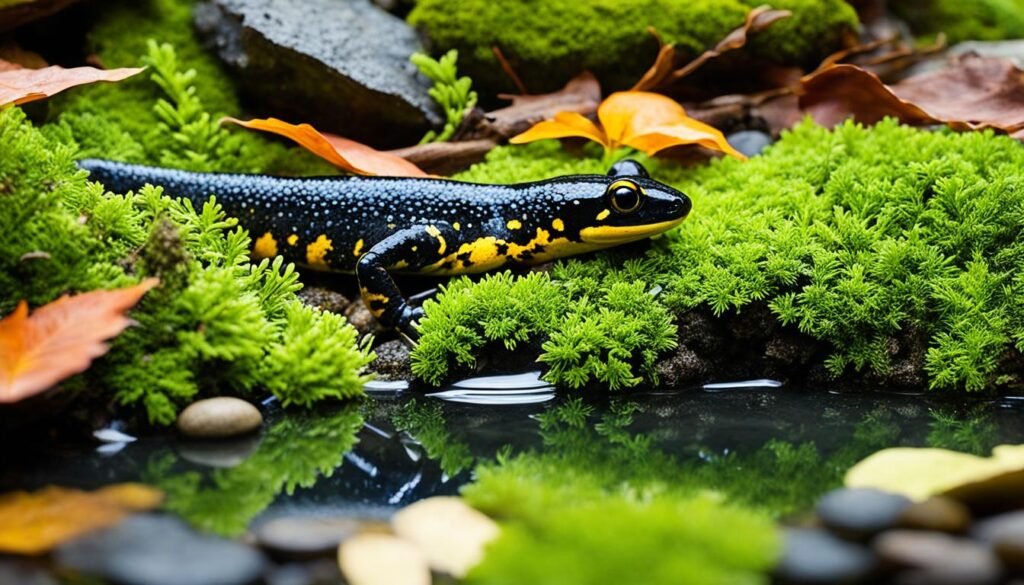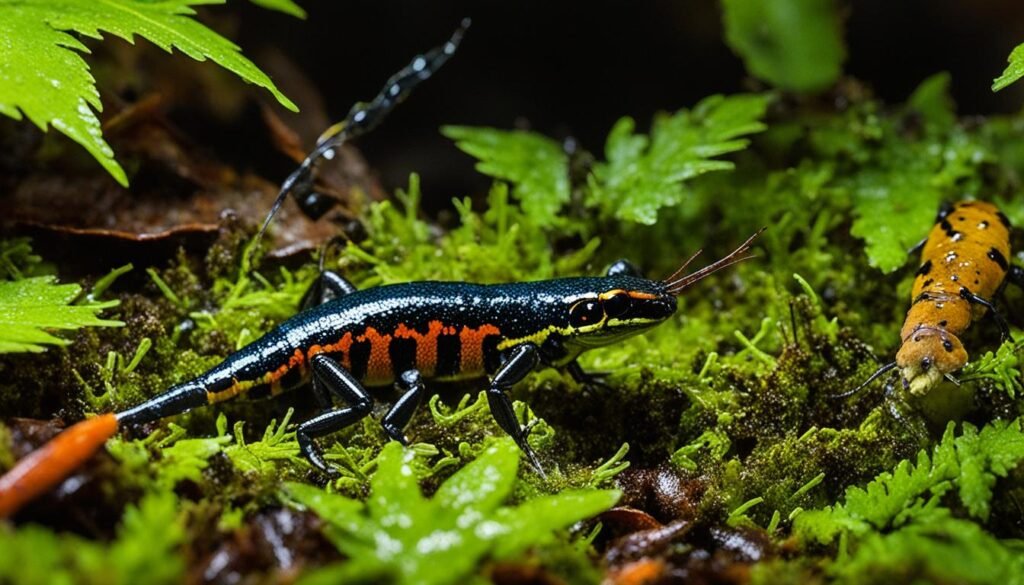Did you know that the fire salamander, scientifically known as Salamandra salamandra, is the first salamander to be formally described in scientific literature? This fascinating amphibian is found in mainland Europe, Mediterranean islands, northern Africa, and the Near East, and it is known for its stunning coloration and unique behaviors.
Key Takeaways:
- Fire salamanders are a species of amphibian found in Europe, Africa, and the Near East.
- They have beautiful coloration and are popular in the pet trade.
- Fire salamanders are nocturnal and display territorial behavior during the breeding season.
- They require a suitable habitat with proper temperature, humidity, and lighting.
- Feeding them a varied diet of live prey is essential for their nutrition.
Fire Salamander Availability
When it comes to acquiring fire salamanders as pets, availability can be a challenge due to the restrictions placed on their importation by European Union laws. Fire salamanders are strictly protected throughout the EU, making it difficult to legally import them into the United States.
However, despite these regulations, fire salamanders can still be found in the U.S. pet trade. Many of these salamanders are sourced from Eastern Europe, where they are collected from the wild.
This practice raises concerns as wild-caught fire salamanders often arrive in poor condition, and there is a risk of unknowingly purchasing non-captive bred individuals. To ensure the welfare of fire salamanders and support sustainable practices, it is essential for potential buyers to seek out reputable breeders who specialize in captive-bred fire salamanders.
By purchasing from reputable breeders who prioritize captive breeding, you can help promote the conservation of these fascinating amphibians while also ensuring healthier and more resilient pets.
Fire Salamander Size
Fire salamanders are fascinating creatures, known for their vibrant colors and unique characteristics. One of the aspects that make them stand out is their size. As one of the larger terrestrial salamanders, fire salamanders display considerable variations in size, which can be influenced by genetics and environmental factors.
Individual fire salamanders can range in length from approximately 5 to nearly 12 inches, making them a substantial presence in the world of salamanders. Their size is determined by a combination of factors, including their species and subspecies.
Fire salamanders reach their full size as they mature, with growth rates varying among individuals. Some species may take longer to reach their maximum size compared to others. Additionally, environmental conditions, such as temperature and food availability, can also impact the growth and size of fire salamanders.
It is important to note that the size of fire salamanders can differ between males and females. In some species, females tend to be larger than males, while in others, both genders have similar sizes.
The Size Range of Fire Salamanders
Here is a breakdown of the size range for some common fire salamander species and subspecies:
| Species/Subspecies | Size Range (Length) |
|---|---|
| Salamandra salamandra | Approximately 5 to 8 inches |
| Salamandra salamandra terrestris | Approximately 6 to 9 inches |
| Salamandra salamandra gallaica | Approximately 7 to 10 inches |
| Other subspecies | Size variations within the overall range of the species |
It’s essential to be aware that these size ranges are general estimates, and variations can occur within each species and subspecies based on individual factors and environmental conditions.
For an immersive visual experience of the beautiful fire salamander, take a look at the image below:
Fire Salamander Lifespan
Ensuring the longevity of your fire salamander requires proper care and attention. With the right conditions and care, these fascinating amphibians can live up to 10 years or more in captivity. Several factors influence their lifespan, including diet, temperature, humidity, and overall habitat conditions.
Let’s take a closer look at these factors:
- Diet: Providing a well-balanced diet is crucial for the health and longevity of your fire salamander. A variety of live prey, such as night crawlers, crickets, waxworms, and mealworms, should be offered regularly to meet their nutritional needs.
- Temperature: Maintaining the appropriate temperature range is important for the well-being of fire salamanders. Temperatures above 74 degrees Fahrenheit can cause stress and health issues, so it’s essential to keep the terrarium within the recommended temperature range.
- Humidity: Fire salamanders require a moist environment to thrive. Adequate humidity levels should be maintained in their habitat to ensure their skin stays healthy and hydrated. This can be achieved by misting the enclosure regularly and providing a moisture-retaining substrate.
- Habitat Conditions: Creating a suitable habitat for your fire salamander is crucial for its overall well-being. This includes providing appropriate hiding spots, a secure lid to prevent escape, and a spacious and well-maintained terrarium.
Fire Salamander Lifespan Factors:
| Factors | Impact on Lifespan |
|---|---|
| Diet | Proper nutrition is essential for a healthy and long lifespan. |
| Temperature | Maintaining the correct temperature range is crucial to prevent stress and health issues. |
| Humidity | Adequate humidity levels help keep their skin healthy and hydrated. |
| Habitat Conditions | A suitable and well-maintained habitat contributes to their overall well-being and longevity. |
By providing the right care, nutrition, and environment, you can ensure that your fire salamander lives a long and fulfilling life in captivity.
Fire Salamander Housing

When it comes to housing fire salamanders, creating a suitable and comfortable environment is essential for their well-being. A well-designed terrarium can provide them with the necessary conditions to thrive.
First and foremost, the terrarium should be spacious enough to accommodate the fire salamanders comfortably. A 10-gallon terrarium is the minimum recommended size for a pair of fire salamanders, but opting for a 20-gallon terrarium will provide them with additional space to move around and explore.
The choice of substrate is crucial for creating a natural habitat for fire salamanders. Moist topsoil, leaf litter, or reptile bedding can be used as substrate options. These materials mimic their natural environment and help maintain appropriate humidity levels.
Providing a hiding spot in the terrarium is vital for fire salamanders, as it allows them to feel secure and reduces stress. Bark tunnels or molded plastic hides can serve as ideal hiding spots. These structures create a cozy and protected area where fire salamanders can retreat to when they desire privacy.
While adult fire salamanders are not proficient climbers, it is still advisable to have a secure lid for the terrarium. The lid serves multiple purposes—it prevents the salamanders from escaping, protects them from potential predators, and helps retain the necessary humidity within the enclosure.
| Fire Salamander Housing | Recommendation |
|---|---|
| Terrarium Size | 10-gallon minimum (20-gallon preferred) |
| Substrate | Moist topsoil, leaf litter, or reptile bedding |
| Hiding Spot | Bark tunnel or molded plastic hide |
| Lid | Secure lid to protect from predators and retain humidity |
Creating an optimal housing setup for fire salamanders ensures their health and happiness. With the right terrarium size, suitable substrate, hiding spot, and a secure lid, you can provide them with an environment that resembles their natural habitat.
Fire Salamander Lighting and Temperature
Fire salamanders are primarily nocturnal creatures, which means they are most active during the night. As such, they do not tolerate strong lighting well. To ensure their well-being, it is recommended to use a daylight spectrum bulb on a timer to create a natural light cycle for them. This will mimic their natural environment and provide them with the lighting conditions they need.
When it comes to temperature, fire salamanders have specific requirements. It is crucial to maintain temperatures below 70 degrees Fahrenheit to prevent stress and potential health issues. High temperatures above 74 degrees can be detrimental to their well-being. Some subspecies originating from southern Europe and the Near East may tolerate slightly higher temperatures, but it is best to avoid temperatures above 80 degrees altogether.
Providing the right lighting spectrum and maintaining appropriate temperature levels are essential for ensuring the comfort and health of your fire salamander.
Fire Salamander Food

Fire salamanders have a diverse diet that consists of live prey, ensuring they receive the necessary nutrition for their well-being. While they primarily feed on night crawlers, they also readily accept other insects such as crickets, waxworms, and mealworms.
Feeding frequency varies based on the age of fire salamanders. Adult fire salamanders should be fed 2-3 times per week, while juveniles require more frequent feedings every 1-2 days. It’s important to note that overfeeding can lead to obesity and health issues, so offering as much food as they can consume in 15-20 minutes is recommended.
Feed Your Fire Salamanders Right
To ensure a balanced and varied diet, it’s essential to provide a combination of different prey options. This diversifies their nutrient intake and promotes overall health and vitality. Below is a list of suitable food options for fire salamanders:
- Night crawlers
- Crickets
- Waxworms
- Mealworms
By offering this range of live prey, you can mimic their natural diet while providing essential nutrients for their growth and development.
Fire Salamander Care Considerations
When caring for fire salamanders, it is crucial to pay attention to several important factors to ensure their well-being and health. Handling them properly, understanding their skin shedding process, providing adequate water and humidity, and maintaining suitable temperatures are key elements of fire salamander care.
Handling with Care
Fire salamanders have parotoid glands that secrete toxins, which can cause skin irritations. Therefore, it’s important to handle them with caution. Always wash your hands before and after handling fire salamanders, or consider wearing gloves as an added protective measure. By practicing proper handling techniques, you can minimize any potential risk of skin irritations.
Sloughing and Shedding
Fire salamanders shed their skin regularly as part of their natural growth process. During this time, it’s common for them to eat their shed skin. This behavior is natural and helps them acquire essential nutrients. As a responsible owner, you should provide a suitable hiding spot and ensure a stress-free environment during the shedding process.
Water, Humidity, and Temperature
Fire salamanders require access to fresh water at all times. Ensure that a shallow dish of water is available in their habitat, and replace it daily to maintain cleanliness.
Proper humidity levels are crucial for fire salamanders, as they have semi-permeable skin that allows them to absorb moisture. Aim for a humidity level between 60% and 80% to create a comfortable living environment. You can achieve this by misting the habitat regularly or using a humidity gauge to monitor the levels.
Temperature control is also important for fire salamander care. Keep their habitat within the appropriate temperature range to ensure their well-being. The optimal temperature for fire salamanders is typically between 60°F and 70°F. Avoid exposing them to extreme temperatures as it may cause stress and affect their health.
By following these care considerations, you can provide a safe and nurturing environment for your fire salamander, ensuring their overall health and happiness.
Conclusion
Fire salamanders are fascinating amphibians with beautiful coloration and unique behaviors. These captivating creatures require specific care considerations to thrive in captivity. Providing a suitable habitat is essential, with proper temperature, humidity, and lighting.
Feeding fire salamanders a varied diet of live prey is crucial for their nutrition. Offering options like night crawlers, crickets, and mealworms ensures a balanced and diverse diet that meets their nutritional needs. However, it is important to handle fire salamanders with caution due to their toxic secretions.
By following these care requirements, fire salamander owners can create a rewarding and enriching experience for themselves and their pets. With the right environment and proper nutrition, these captivating creatures can live long and healthy lives. Their unique behaviors and beautiful coloration make them a joy to observe and care for.
So, if you are considering keeping fire salamanders as pets, remember to provide them with a suitable habitat, a varied diet, and handle them carefully. By providing the best care possible, you can enjoy a fascinating and rewarding journey with these enchanting amphibians.
FAQ
What is a fire salamander?
Why are fire salamanders popular in the pet trade?
Are fire salamanders protected?
Where do fire salamanders in the pet trade come from?
What is the size range of fire salamanders?
How long can fire salamanders live in captivity?
What are the housing requirements for fire salamanders?
How should fire salamanders be fed?
Are fire salamanders safe to handle?
What care considerations are important for fire salamanders?
References
| Organization Name | URL |
|---|---|
| International Reptile Conservation Foundation (IRCF) | https://www.ircf.org/ |
| Herpetological Conservation International | https://herpconservation.com/index.html |
| Society for the Study of Amphibians and Reptiles (SSAR) | https://ssarherps.org/conservation/conservation-resources/ |
Please check our other articles which you might be interested on Sand Lizard and Facts About Turtles


6 thoughts on “Fire Salamander Guide: Care, Habitat & Facts”